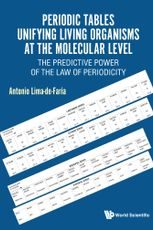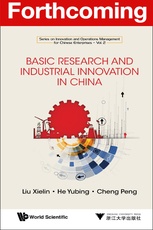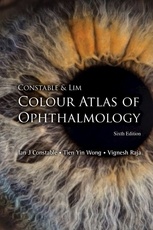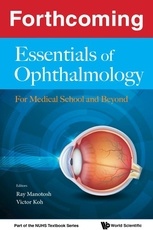
Periodic Tables Unifying Living Organisms at the Molecular Level: The Predictive Power of the Law of Periodicity
Authors : Antonio Lima-de-Faria (Lund University, Sweden)
Publisher : World Scientific
ISBN : 978-981-3227-00-2
There are currently no reviews for this book title.
The DNA sequencing of a series of living organisms has elucidated many biological problems. But the internal atomic and electronic evolution of DNA remains to be mapped in detail. RNA and DNA now appear to be the prime determinants of biological evolution leading to the sudden appearance of novel organism structures and functions that emerge "ready made" as a surprise to the organism. This has been demonstrated by the manipulation of genes that led to the sudden production of additional complete wings and legs in flies and birds. The study of this internal atomic construction of macromolecules is being investigated at the large electron accelerators such as the MAX IV Synchrotron Radiation Laboratory, Lund University, Sweden.
The periodicity of the chemical elements is well known from its iconic Table. Significantly, this periodicity can now be seen to extend to the properties of living organisms. Biological properties as different as: flight, vision, luminescence and regeneration, as well as others, show unexpectedly periodic emergence. They resurface, without previous announcement, in most unrelated plant and animal families and they emerge irrespective of whether the organism is a simple invertebrate or a most complex mammal.
Moreover, this periodicity does not necessarily start at the cell or DNA levels but appears initially in crystals and minerals, where it is shown to be a pure atomic and electronic process, e.g. in luminescence and regeneration.
The assembled molecular evidence led to the construction of Periodic Tables of living organisms, placing them in a position comparable to the periodicity of the chemical elements. Surprisingly, there are striking resemblances between the periodicities of the chemical elements and those of living organisms. In addition, the two types of Tables increase our insight into the events directing atomic evolution since the periodic law established in chemical elements turns out to be applicable to the periodicity of living organisms. The new Periodic Tables introduce a predictive capacity in biological evolution that before was hardly contemplated.
Eric Scerri, from the Department of Chemistry and Biochemistry, California University, Los Angeles, who is the Author of the book "The Periodic Table. Its Story and its Significance", Oxford University Press, stated in an e-mail that "Professor Lima-de-Faria's book is wonderful and a pioneering work".
The periodicity of the chemical elements is well known from its iconic Table. Significantly, this periodicity can now be seen to extend to the properties of living organisms. Biological properties as different as: flight, vision, luminescence and regeneration, as well as others, show unexpectedly periodic emergence. They resurface, without previous announcement, in most unrelated plant and animal families and they emerge irrespective of whether the organism is a simple invertebrate or a most complex mammal.
Moreover, this periodicity does not necessarily start at the cell or DNA levels but appears initially in crystals and minerals, where it is shown to be a pure atomic and electronic process, e.g. in luminescence and regeneration.
The assembled molecular evidence led to the construction of Periodic Tables of living organisms, placing them in a position comparable to the periodicity of the chemical elements. Surprisingly, there are striking resemblances between the periodicities of the chemical elements and those of living organisms. In addition, the two types of Tables increase our insight into the events directing atomic evolution since the periodic law established in chemical elements turns out to be applicable to the periodicity of living organisms. The new Periodic Tables introduce a predictive capacity in biological evolution that before was hardly contemplated.
Eric Scerri, from the Department of Chemistry and Biochemistry, California University, Los Angeles, who is the Author of the book "The Periodic Table. Its Story and its Significance", Oxford University Press, stated in an e-mail that "Professor Lima-de-Faria's book is wonderful and a pioneering work".
After editing the Handbook of Molecular Cytology 1969, Antonio Lima-de-Faria wrote Molecular Evolution and Organization of the Chromosome 1983, and Evolution without Selection. Form and Function by Autoevolution 1988. This last book was translated into Russian, Japanese and Italian. Later he wrote Biological Periodicity. Its Molecular Mechanism and Evolutionary Implications 1995 (translated into Japanese) and One Hundred Years of Chromosome Research and what Remains to be Learned 2003. Subsequently appeared Praise of Chromosome "Folly". Confessions of an Untamed Molecular Structure 2008 (translated into Russian), Molecular Geometry of Body Pattern in Birds 2012 and Molecular Origins of Brain and Body Geometry 2014. He is professor emeritus of Molecular Cytogenetics at Lund University, Lund, Sweden. His work in molecular biology has won him, among other honors, the decoration Knight of the Order of the North Star by the Swedish King and Great Official of the Order of Santiago by Portugal's President. He is member of five scientific academies.
There are currently no reviews for this book title.
Buy this book, http://www.worldscientific.com/worldscibooks/10.1142/10625, 9655, false
FAQs
Click on the "Buy this book" button
You can email us at book-review@enago.com and we will get back to you with the next steps shortly.
New Releases
-

Advances in the Molecular Understanding of Colorectal Cancer
-

Basic Research and Industrial Innovation in China
-

Constable & Lim Colour Atlas Of Ophthalmology: Sixth Edition
-

Essentials of Ophthalmology: For Medical School and Beyond
-

Fixed Revenue Accounting: A New Management Accounting Framework
All featured publishers and authors can avail of a free promotional interview on Enago Academy! Write to us now!
